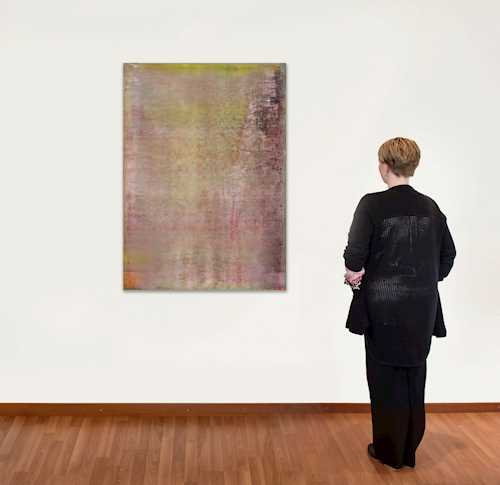
拍品 3484 - A201 战后和当代 - Donnerstag, 30. Juni 2022, 05.00 PM
GERHARD RICHTER
(Dresden 1932–lives and works in Cologne)
Kine. 1995.
Oil on canvas.
Signed and numbered on the reverse: Richter 832-1.
124 × 90 cm.
Provenance:
- Marian Goodman Gallery, New York.
- Purchased from the above in 1997 by the present owner, since then privte collection Switzerland.
Exhibitions:
- Nimes 1996, Gerhard Richter. 100 Bilder. Carré d'Art, Musée d'Art Contemporain, p. 114 (with colour ill.).
- New York 1996, Marian Goodman Gallery. Gerhard Richter.
Literature:
- Elger, Dietmar: Gerhard Richter. Catalogue Raisonné, vol. 5, nos. 806-899-8, 1994 - 2006, Ostfildern 2019, no. 832-1 (with colour ill.).
- Exh.cat. Anthony d'Offay Gallery: Gerhard Richter, London 1998, p. 95 (with colour ill.).
- Exh.cat. K20 Kunstsammlung Nordrhein-Westfalen: Gerhard Richter, Düssedorf 2005, p. 277 (with colour ill.).
- Heffernan, James A. W.: Cultivating Picturacy. Visual Art and Verbal Interventions, Waco 2006, p. 304.
- Heffernan, James A.W.: Speaking for Pictures. Language and Abstract Art, in: Homem/Lambert (ed.): Writing and Seeing. Essays on Works and Image, Amsterdam/New York 2006, p. 41.
“A work of art is not about teaching. Pictures that can be interpreted and that contain meaning are bad pictures. A picture emerges as unclear, illogical, nonsensical. It demonstrates the innumerability of aspects; it takes away our security because it takes away our opinion and the name of a thing. It shows us the thing in its multiplicity and infinity, which do not allow for an opinion or point of view." Gerhard Richter
Gerhard Richter, who is now 90 years old, is undoubtedly one of the most influential and important artists of our time. His works were and still are included in countless group and solo exhibitions. Numerous prizes pay tribute to his artistic importance: for example, he was awarded the Arnold Bode Prize in 1982, the Oskar Kokoschka Prize in 1985, the Kaiserring of Goslar in 1988, the Golden Lion of the Venice Biennale in 1997, and many more. His works are to be found in the collections of the most important international museums. Moreover, some of his works, such as "Ema (Nude on a Staircase)" (1966), the series of "Candles" (from 1982) and "Uncle Rudi" (1965), have become icons of art history. Other works such as "Tante Marianne" (1965) or the cycle "18. Oktober 1977" (1988) are icons of German history and debate.
His impressive, comprehensive, and meticulously documented oeuvre encompasses techniques ranging from painting to graphics, multiples, sculptures, video works and installations. His photorealistic motifs permeate his entire oeuvre, while he explores the most diverse ways of representing abstract art. Richter's love of experimentation, creativity, and fearlessness in exploring new avenues seem to know no bounds, making his work unique.
1994, the year before the present work was created, marked a significant turning point in his artistic career. With the comprehensive retrospective which toured from the Musée d'art Moderne de la Ville de Paris to the Kunstmuseum Bonn, the Moderna Museet in Stockholm and the Reina Sofia in Madrid, Richter was finally established as one of the most important and influential artists in Europe. In 2002, the retrospective at the Museum of Modern Art in New York also reinforced this success worldwide.
"Kine" from 1995 is an exemplary work from the period between 1994 and 2006, which saw a departure from his previous painting style. "Richter's abstract paintings in this phase of his work deny the public precisely those qualities which they had so appreciated in his abstractions before: the new paintings are less colourful and decorative, more restrained in colour, more brittle, more contradictory and more challenging. Richter also concentrates more on smaller formats." (quoted in Elger, Dietmar: Gerhard Richter. Catalogue Raisonné, vol. 5, Nos. 806-899-8, 1994 - 2006, Ostfildern 2019. p. 45). Delicate pink tones, yellow and orange which shimmer from underneath, as well as light brown tones, but then also green tones created by mixing, all determine the colour palette. The skilful combining of colours, allowing new colours to emerge as a result, a quality of permeability through the skilful removal and blurring of colours, all serves to create a harmonious and intense colour composition.
With this work, the artist challenges the viewer to comprehend his work in all its details. The colour palette is enhanced by the consummate interplay of colours. The dynamics inherent in the painting are restrained, but then surprisingly strong due to the brushstroke and colour gradients. For Gerhard Richter, abstract paintings are metaphors of social coexistence. Thus, in his compositions, he brings together the most diverse and contradictory elements in a lively manner with the greatest possible freedom.
The present work appears almost like a blurring of Monet's “Water Lilies”. Although Gerhard Richter's oeuvre focuses on such diverse areas as photorealism, landscape depictions and abstraction, "Kine" strikingly demonstrates how such different artistic modes of expression can be interdependent in Richter's work. There are numerous instances, for example, of landscape depictions that are the starting point for abstract paintings. Despite the clearly abstract nature of our work and the absence of any representational elements, to associate it with a rose garden or waterlily garden would not be so far off.
CHF 3 000 000 / 5 000 000 | (€ 3 092 780 / 5 154 640)


